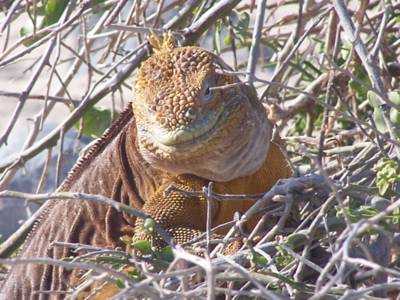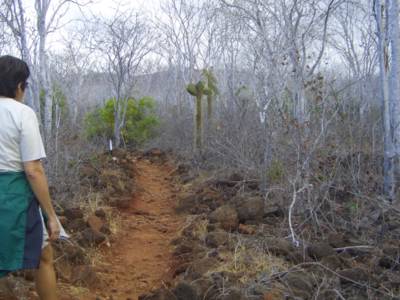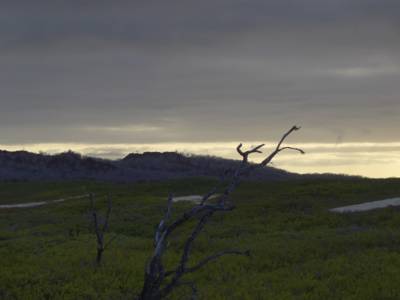

Just after landing at Dragon Hill, we arrived at a small lagoon with a couple of flamingos. It was beautiful, but not exciting from a wildlife perspective. In Sarasota, we get to see loads of flamingos at Jungle Gardens or in Tampa at Busch Gardens. I bought a Busch Gardens pass one year just so I could take lots of video footage of the flamingos. They are graceful, shapely, enigmatic, colorful, social, and make a great composition.
However, we did see some large land iguanas and the “foxholes” they call home. On some islands, the endemic species have been decimated over the last century primarily due to the introduction of domestic goats that are now wild (feral). Campaigns to eradicate these pests have been successful in some areas and have been stepped up in others. Land iguanas have been one victim of feral goats and pigs. Consequently, at the Charles Darwin Station, there is an ongoing program to breed iguanas and reintroduce them into the wild. The population of land iguanas here at Cerro Dragon is a direct result of this reintroduction.

A couple of months ago, I read in the Nature Conservancy magazine that rats, accidentally introduced from passing ships, are a huge problem for bird populations in the northern Pacific. When a particular bird gathers in large numbers in one location, they are exceptionally vulnerable to a rapid decline even with a relatively small rat population. In much the same way, since many species in the Galapagos only exist on a handful of islands, there has been a huge wave of extinctions or near-extinctions since people first brought domesticated animals here.
We also passed through forests of palo santo trees, also known as incense trees, along our walk. At this time of year, they present as a white forest with no leaves yet budding out. Although, we have seen them elsewhere, here they were thick enough that we could smell their aromatic essence as we walked along. On the other islands, I could rub my fingers on sap that ran down the trunk to capture their wonderful smell for a while, but in the palo santo forest, it wasn’t necessary.


After the walk, we snorkeled amidst large schools of fish. Again, the visibility wasn’t terrific, but it was fun.

No comments:
Post a Comment